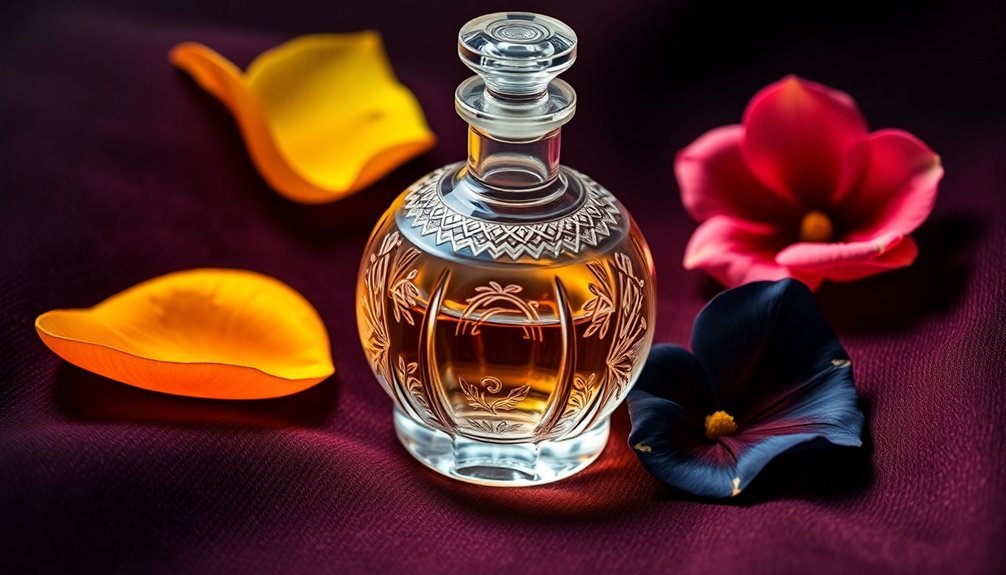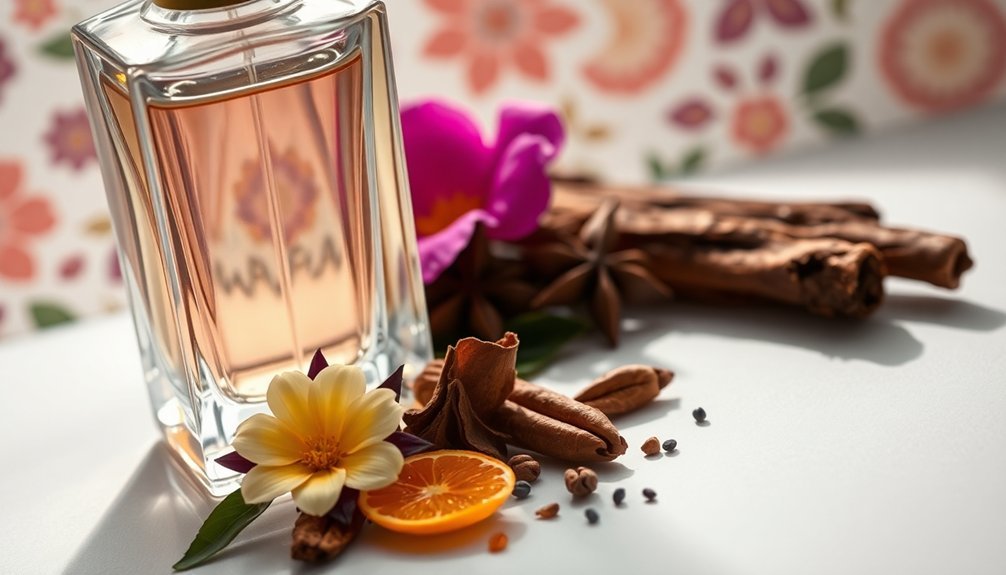Perfumes follow a three-note symphony pattern to mirror how scents naturally unfold on your skin over time. You'll experience the bright, volatile top notes immediately upon spraying, followed by the heart notes that emerge within an hour to reveal the fragrance's true personality. Finally, the rich base notes create a lasting foundation that can linger for hours. This carefully engineered progression guarantees you'll discover new layers of complexity as your fragrance journey unfolds.
The Art and Science Behind Three-Layered Fragrance Design

While many people focus on a fragrance's initial impression, perfume design is actually a sophisticated blend of art and science that unfolds in three distinct layers. Each layer plays a vital role in creating a harmonious scent experience, from the fleeting top notes to the lasting base notes. The first scents perceived create an immediate sensory impact when the perfume is sprayed.
You'll find middle notes emerging after 20-60 minutes, featuring warm florals like rose and herbaceous elements like lavender. These notes create a seamless bridge to the foundation, where larger molecules in base notes like sandalwood and vetiver provide depth and longevity.
The science behind this layering involves careful molecular engineering – smaller molecules evaporate quickly while larger ones linger. When you're wearing a well-crafted perfume, you're experiencing a carefully orchestrated dance of chemistry where each note shifts smoothly into the next, creating a balanced and evolving sensory journey.
Understanding Top Notes: The First Impression Makers
When you first spray a perfume, you'll experience the immediate burst of top notes that create your first impression of the fragrance.
These light, volatile notes quickly evaporate within 5-15 minutes, featuring fresh scents like citrus, light florals, and herbs that catch your attention.
You'll notice their swift shift as they fade, making way for the fragrance's deeper layers while having served their essential role as the perfume's initial attractors. Bergamot and grapefruit are among the most commonly used top notes that perfumers select for their bright, zesty character.
Immediate Impact and Appeal
Have you ever wondered why certain fragrances capture your attention within seconds of application? It's all about the top notes – those initial scents that greet your nose and set the stage for your entire fragrance experience.
These opening notes typically last 15-30 minutes and feature light, vibrant ingredients like citrus, fresh herbs, and sweet fruits. You'll often encounter bergamot, mint, lavender, or pink pepper creating that first memorable impression. Clean, unscented skin provides the best surface for experiencing these delicate top notes.
Through your olfactory system, these notes can trigger immediate emotional responses, spark memories, and even influence your mood.
As the first act in the fragrance pyramid, top notes aren't just about smelling good – they're designed to entice you into exploring the complete scent journey while creating a seamless shift to the heart notes that follow.
Volatile Nature Explained
The fascinating science behind top notes reveals why your first whiff of perfume doesn't last long. These volatile components contain smaller, lighter molecules that evaporate quickly, typically within 5-15 minutes of application. Their high volatility and interaction with your skin's chemistry create that initial burst of fragrance you experience.
Understanding top notes comes down to three key factors:
- They're composed of light oils featuring citrus, floral, or herbal elements.
- They sit at the peak of the fragrance pyramid, designed for quick evaporation.
- They're specifically crafted to shift smoothly into middle notes.
While fleeting, top notes aren't just about first impressions – they're essential in harmonizing the entire fragrance composition, blending with middle and base notes to create a well-rounded perfume experience.
Fresh Scent Duration
Since first impressions matter greatly in perfumery, top notes play an essential role in capturing your attention within seconds of application.
You'll notice these fresh, light scents typically last between 5 to 30 minutes, though some may linger for a couple of hours. The duration largely depends on your skin type, with oily skin retaining the fragrance longer than dry skin.
You can extend your fresh scent's longevity by applying perfume to your pulse points and choosing higher concentrations like Eau de Parfum.
Environmental factors like temperature and humidity will affect how long these notes last.
When you're selecting a fresh fragrance, look for citrus elements like bergamot and lemon, or light florals and herbs.
These ingredients create that initial burst of freshness before seamlessly shifting into the heart notes.
Heart Notes: The Soul of Every Perfume
Deep within every perfume's structure lies its heart notes, emerging after the initial burst of top notes fades away.
These notes form the core character of your fragrance, lasting several hours while defining its unique personality and atmosphere.
You'll discover heart notes are more complex and robust than top notes, often featuring:
- Floral elements like rose and jasmine for romantic depth
- Warm spices such as cinnamon and cardamom
- Ripe fruits including peach and blackcurrant for juicy richness
When you wear a perfume, its heart notes bridge the gap between the fleeting top notes and lasting base notes.
They'll interact uniquely with your body chemistry, creating a personal olfactory experience that reflects your style.
Both natural and synthetic ingredients work together to provide authenticity and innovation in this vital middle layer.
Base Notes: Creating Lasting Memories

Base notes create an enduring foundation that you'll notice lingering on your skin long after the top and heart notes fade away.
You'll experience these rich, warm scents as they slowly emerge to form the lasting memory of your chosen fragrance.
Your perfume's longevity depends heavily on these deep-anchoring notes, which often include woods, musks, and resins that can stay with you for hours or even days.
Deep Scent Anchor Effects
When perfumers craft memorable fragrances, they rely heavily on base notes to create deep, lasting impressions that linger in both scent and memory.
These heavier molecules serve as anchors, stabilizing the entire fragrance composition while enhancing its longevity on your skin.
The anchoring effects of base notes work in three distinct ways:
- They slow down the evaporation of lighter top notes through their fixative properties.
- They create a buffer zone that smooths the shift between heart notes.
- They interact with your skin chemistry to reveal the fragrance's true character over time.
You'll find common base notes like cedarwood, vanilla, and musk working synergistically with other ingredients to create complex accords.
As these notes unfold, they'll provide the rich, smooth foundation that makes your fragrance truly unforgettable.
Foundation Of Fragrance Longevity
Lasting fragrances build their power from the ground up, starting with the foundational elements known as base notes.
These heavy-molecule ingredients are your fragrance's anchor, working tirelessly to extend the scent's life on your skin for hours or even days.
You'll find base notes like sandalwood, musk, and vanilla interacting with your body's natural oils and heat, slowly releasing their deep, rich aromas.
They're not just working alone – they're actively stabilizing the entire fragrance composition by slowing down the evaporation of lighter top and heart notes.
When you're in the final dry-down phase, these base notes reveal the perfume's true signature, leaving you with a warm, sensual finish that can last all day.
They're the reason your favorite scent lingers as a memorable olfactory experience.
The Natural Evolution of Scent Throughout the Day
Throughout the day, fragrances naturally evolve and transform to match different moments and activities in our lives.
You'll notice that your daytime scents feature fresh, crisp notes like citrus and light florals, while evening fragrances embrace warmer, more sensual elements such as vanilla and amber.
To maintain an effective scent shift from day to night, consider these key strategies:
- Layer your fragrances strategically by applying an evening scent over the lingering notes of your day perfume.
- Use complementary scented body products to enhance your fragrance's staying power.
- Time your reapplication for late afternoon to create a seamless evolution into your evening scent.
This natural progression guarantees your fragrance remains appropriate for each setting while maintaining your signature style throughout the day.
Historical Origins of the Three-Note Classification

As perfumery evolved from ancient ceremonial incense to modern fragrance artistry, the three-note classification system emerged as a revolutionary framework for understanding scent composition. You can trace this development through centuries of innovation, from the Mesopotamians' early incense rituals to the sophisticated perfumes of today.
The true breakthrough came when French perfumer Jean Carles formalized the fragrance pyramid concept, introducing a structured approach to perfume creation. This system wasn't just arbitrary – it was based on the scientific understanding of how different scent molecules evaporate at varying rates.
While ancient civilizations like the Greeks and Romans laid the groundwork for liquid perfumes, it wasn't until the integration of modern chemistry and the rise of synthetic ingredients that perfumers could fully exploit this three-tiered structure in their compositions.
Chemical Harmony in Modern Perfumery
Modern perfumery masterfully blends scientific precision with artistic intuition to create harmonious fragrances that unfold like musical compositions.
You'll find perfumers working in lab-like settings, carefully selecting high-quality ingredients and combining them with calculated precision to achieve the perfect balance.
The creation of a perfume follows three essential patterns:
- Top notes provide the initial impression with light, citrusy scents that quickly evaporate.
- Middle notes emerge next, featuring floral or spicy elements that bridge the composition.
- Base notes anchor the fragrance with deep, lasting scents like musk or vanilla.
You'll discover that today's perfumers prioritize sustainable sourcing practices and use both natural and synthetic ingredients to craft their olfactory symphonies.
The fragrance wheel helps them identify complementary notes, ensuring each scent tells its unique story through chemical harmony.
Molecular Dance: How Notes Interact With Skin Chemistry

While every perfume carries its own unique composition, the way it interacts with your skin chemistry creates a truly personal fragrance experience. Your skin's natural pH, oils, and moisture levels play vital roles in how fragrance molecules develop and project throughout the day.
If you have oily skin, you'll notice that perfumes tend to last longer and project more intensely, while dry skin causes faster evaporation. Your body temperature also affects how the scent unfolds – warmer skin intensifies the fragrance but may cause it to fade more quickly.
Even your diet and lifestyle choices influence how a perfume performs on your skin. You'll get better longevity by applying an unscented moisturizer before your fragrance, as this creates an ideal base for the molecules to adhere to.
Master Perfumers' Secrets to Note Balancing
Master perfumers rely on precise mathematical ratios and time-tested techniques to create perfectly balanced fragrances.
You'll find their carefully calculated formulas typically follow these proportions: middle notes comprise 50-75% of the blend, top notes make up 20-40%, and base notes account for 5-10%.
When you're learning to blend like the masters, remember these essential techniques:
- Start with a drop-by-drop approach using each note category
- Record every addition in a dedicated notebook for consistency
- Experiment with different ratios like 1:1:1 or 3:2:1
The key to successful blending lies in creating sophisticated accords – combinations of two to three complementary notes that work together seamlessly.
You'll notice these accords enhance your fragrance's complexity while ensuring the notes shift smoothly from top to base.
The Role of Volatility in Note Classification

Understanding how volatility works in perfumery will help you grasp why fragrances evolve over time. When you first spray a perfume, you'll notice the top notes immediately – these light, small molecules evaporate within minutes, creating your first impression of the scent.
The molecular weight of ingredients determines their classification and longevity. You'll experience heart notes emerging after the top notes fade, lasting several hours.
Base notes, with their heavy molecules, provide the foundation and can last beyond 24 hours.
You'll find that each note plays a specific role in the fragrance's development. Heart notes mask the initial base notes while bridging the gap between top and bottom layers.
This careful arrangement of different volatility rates creates the symphony of scents you experience throughout the day.
Building Your Signature Scent Using the Three-Note System
Creating your signature scent begins with three essential building blocks – top, middle, and base notes.
By understanding how these layers work together, you'll craft a fragrance that truly represents your personality and remains balanced throughout the day.
To build your perfect scent combination:
- Start with fresh top notes like citrus or lavender that make a strong first impression and set the tone for your fragrance journey.
- Layer in full-bodied middle notes such as jasmine or cinnamon, which will intensify your scent and make up the majority of its character.
- Anchor everything with rich base notes like vanilla or sandalwood that provide depth and guarantee your fragrance lasts.
Don't be afraid to experiment with different combinations until you find the perfect blend that matches your style and desired longevity.
Cultural Influences on Note Selection and Combinations

While personal preference shapes your signature scent, cultural heritage often plays a defining role in fragrance selection.
You'll find that Middle Eastern perfumes embrace rich ouds and earthy notes, while Mediterranean fragrances celebrate citrus and neroli. In Asia, jasmine and frangipani dominate, reflecting spiritual traditions and tropical landscapes.
Your cultural background might draw you toward specific note combinations. If you're from France, you're likely attracted to musky, dark profiles, while American roots might pull you toward sweet, gourmand scents.
Traditional ingredients carry deep meaning too – agarwood's earthiness in Middle Eastern perfumery, spices in Indian fragrances, and powdery florals in British scents all tell cultural stories.
As you build your signature scent, consider how these cultural influences align with your personal fragrance journey.
Frequently Asked Questions
Can Someone Be Allergic to Specific Fragrance Notes?
Yes, you can be allergic to specific fragrance notes in any layer – top, middle, or base. You'll find that your body may react differently to various ingredients through skin irritation or allergic reactions.
Why Do Some Perfumes Smell Different on Different People?
Your unique skin chemistry, including pH levels, natural oils, and bacteria, interacts differently with perfume molecules. Temperature, humidity, and hormones also affect how a fragrance develops on your skin throughout wear time.
Is It Safe to Layer Multiple Perfumes Containing Similar Notes?
While you can layer perfumes with similar notes, it's safer to limit yourself to two fragrances. Test combinations on your skin first, as multiple scents can overload your skin with allergens and trigger reactions.
Do Temperature and Humidity Affect How Fragrance Notes Develop?
Yes, temperature and humidity dramatically affect your fragrance's development. Heat speeds up evaporation and highlights top notes, while humidity prolongs longevity. Cold weather emphasizes base notes and keeps scents closer to your skin.
Can Certain Medications Alter How Perfume Notes Interact With Skin?
Yes, medications like GLP-1s can alter your skin's chemistry and hormone levels, affecting how perfume notes develop. You'll notice changes in fragrance longevity, and you might need to adjust your perfume choices accordingly.
In Summary
Understanding the three-note symphony of perfumes lets you make smarter fragrance choices. You'll know why your scent changes throughout the day and how to pick fragrances that evolve beautifully on your skin. Whether you're crafting your signature scent or exploring new fragrances, remembering the interplay of top, heart, and base notes will help you select perfumes that tell your unique olfactory story.





Leave a Reply